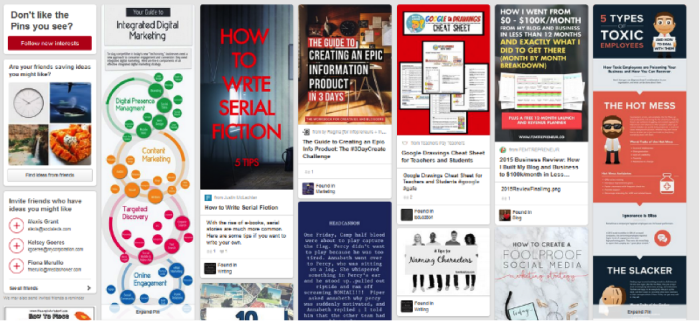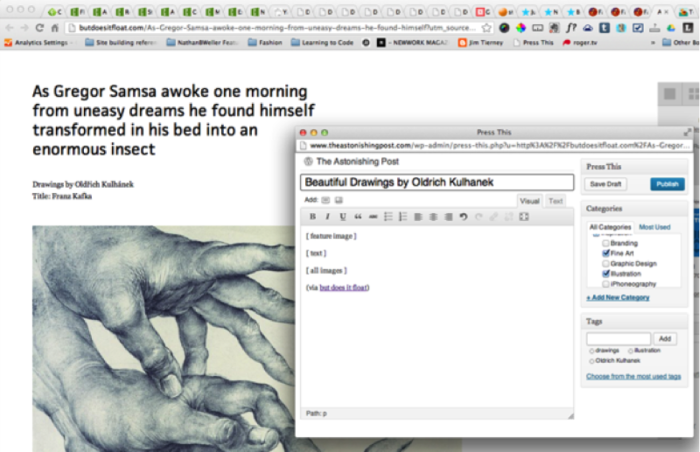As a student, I hated research papers.
Searching for the right resources, taking notes, organising all of that information, developing a thesis – all of this before I could even begin to write, the only part I actually liked.
When I got into content writing, and specifically content curation, it hit me. All of the old hatred of research papers bubbled up. But things have changed. Content curation tools have done the hard work for me, and there are 12 that have turned me into a “curation machine.” Life is good again.
I use content curation tools for two purposes – to find great stuff that I can re-purpose, re-write and publish and to share great content that others in my niche have produced.
To find that content and to get it organised, these are the best content curations tools I have found.
1. Trap.it

Trap.it is a cool and “smart” tool. The more you use it to find content, the smarter it gets. Pretty soon it is literally trapping content from all over the web and putting it in folders, neatly organized for you to access whenever you need information, research, or data. It keeps on working for you while you are onto other things.
2. Quora

A lot of content writers don’t use this, but I love it. Once you set up an account, you can search by keywords for content from all over the web. All of this content can be stored via your account. But here’s the other thing: you can set up “alerts,” based on those keywords, and when content is found it will be sent to your inbox.
3. Scoop.it

This is somewhat like Trap.It but a bit different. You join, conduct “smart searches” based on keywords, take what is important or relevant to you, and then re-purpose/re-write it. Once you have done this, you can complete a 1-click publishing to your blog and any social network platforms. Pretty slick.
4. Pinterest

Yes, I use Pinterest, and here is how. I follow people in my niche, see what they are posting, and copy that stuff to my own boards on my account. When I am looking for new content ideas, I access my boards and rummage through them. More than once, I have generated a great idea for a post of my own.
5. My Curator (for WordPress)

If you have WordPress (and who doesn’t), this is a plugin you must have. This will bring in content on a regular basis for you to read and review. It’s really a constant flow, and you can get lots of ideas.
6. Buzzsumo

Here’s what I love about this tool. You can type in keywords and immediately get a full “report” of the site and blogs that have published related content, as well as those pieces that have received the most views and where the most conversation is going on. It’s great to know what target audiences are discussing and what their questions are. It can drive content that you then decide to write. Plus, you can immediately access these posts and articles, writer better ones, and get a “leg up” on the competition.
7. Write My Paper

This writing service has a full staff of copywriting pros. If I am running out of time but have a great idea for content, I can access their site, fill out an order, and have a fully written piece in short order. These folks really do it right!
8. Learnist

One of the things about content writing is you have to stay current. If you are not producing stuff that people really want to read right now, you are left in the dust. This great tool lets you in on what your niche leaders are producing and discussing. You have to keep learning, and this is your chance to do that.
9. SlideShare

What a great resource. It is like no other that is mentioned here. But you can learn a lot here. Searching by keywords, you can bring up slideshares from others in your niche, go through them quickly without a lot of text reading, and come up with some great idea for content topics. And if you are feeling magnanimous, you can create a slide share of your own that others could use too.
10. Pocket

You are busy, and don’t always have the time to read content that you find and review it for potential topic ideas. But when you do come across something that you know will be useful at some point, you simply drop it into your Pocket account and there it will stay until you do have the time. You can categorise by sub-topics and save anything from blog posts, to articles, to inforgrahics, to videos.
11. Storify

Stories are one of the biggest draws that attract readers and keep them engaged. This is a tool that will just be fun to use. You can take visual content that is posted anywhere and drag and drop it into your own files. And you can also use others’ storyboards and curate content from those. Whenever you can weave a story into your content, you win! (PS: There is a WordPress plugin for Storify).
12. Curata

This is the tool I should have had in college. Omg – so amazing. You supply the keywords, Curata does the rest. It combs through the internet and generates lists of content sources for you to access and review. This is the lazy person’s type of research, and who doesn’t love that?
Obviously, there are many more content curation tools than the 12 listed here. But, if you start with these, okay, just some of these, you will find your job of finding good content a “slam-dunk.” It almost makes me wish I were a student facing those research papers again. Wait – no – I can’t go that far.


As an content curator this post is yet to bookmark and i loved how you comprised all of this info as an resource for individuals to help out while writing... amazing cheapest essays writing
ReplyDeleteTriberr is an exquisite content material curation device for bloggers, influencers, and small organizations trying to construct a target market via content material Auto Garage Dubai advertising. Triberr enables you to discover, curate, and sell content material, as well as tune your dreams.
ReplyDelete